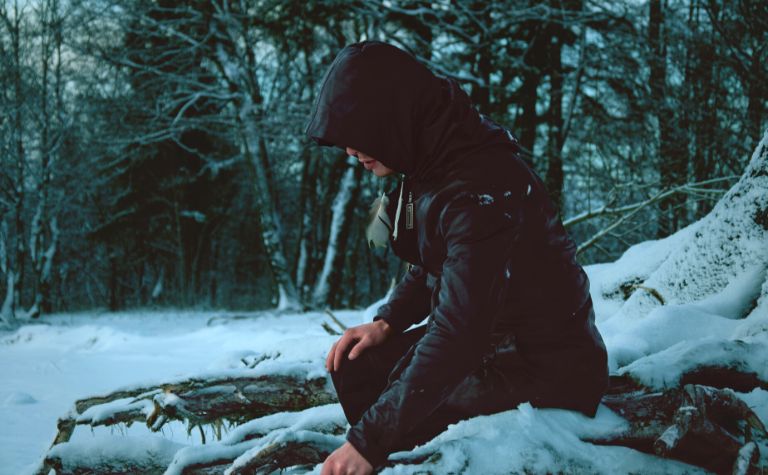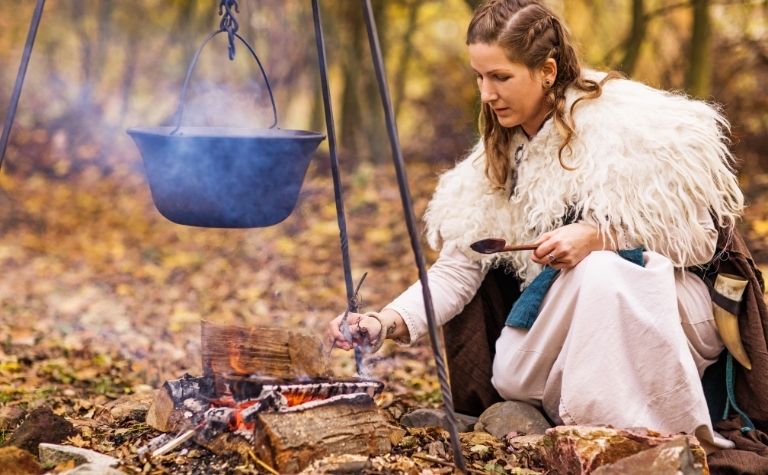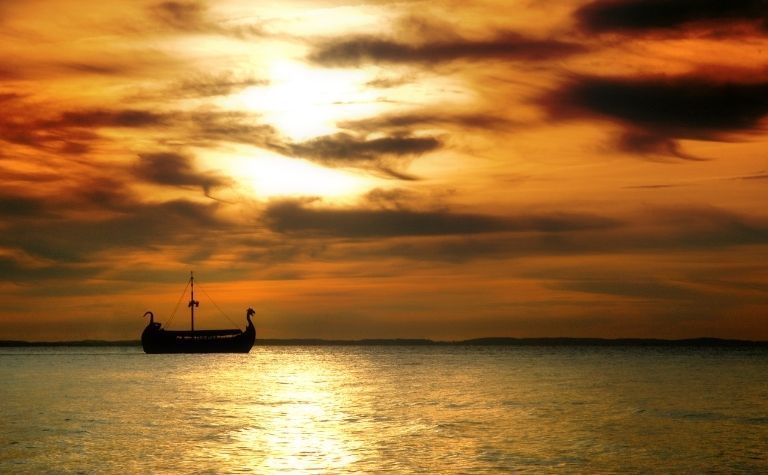The Vikings have a reputation for being the toughest of people. However, recent findings have suggested that they may have been much more susceptible to the vagaries of the weather than is commonly assumed.
How did they survive the icy climes of the furthest northern reaches of Western Europe?
The Vikings stayed warm by wearing layered, woolen clothing and supplementing their regular diets with nutrient-rich foods like fish, honey, and mead.
They also lived in heated, well-insulated, windowless longhouses that sometimes housed their cattle.
This article will explain how the Vikings survived in some of the most inhospitable terrains.
Large numbers of humans have consistently occupied and thrived as a culture despite these constraints. [1] [2] [3]
Also, see 11 Facts About Viking Longhouses to learn more.

How did Vikings survive the cold?
Vikings survived cold by tailoring their clothes, homes, and diets to the challenges of living in a cold climate.
They also avoided prolonged exposure to extreme cold where possible. Besides, temperatures in the areas the Vikings lived in were much warmer than is commonly imagined.
The Vikings tailored all aspects of their lives to counter the challenges of living with extreme cold. This included the clothes they wore and their diets.
Viking clothing was hardy, practical, and made from materials that hold up well in cold weather, such as wool, leather, and fur.
Most Vikings wore clothes made of wool that helped them stay extremely warm even when wet.
Additional outer layers of fur or leather provided additional protection from the cold.
Both men and women also wore base layers of linen under their tunics. Finally, hats, socks, leggings, and cloaks helped protect extremities and add a final layer of warmth.
Similarly, Viking diets too had to account for the shift of seasons.
Often, Vikings had to accommodate for temporary scarcity or crop failures due to unseasonal weather. Nutrient-rich foods that were readily available were used to supplement or replace the Vikings’ diets in these instances.
Examples of foods used to bolster the Vikings’ winter diets include fish and honey.
Honey was also the main ingredient of the Viking’s favorite alcoholic beverage, mead.
Famous for their appetite for drink, the Vikings particularly enjoyed their mead during winter, when they would gather indoors for long banquets.
Likewise, the iconic Viking longhouse was particularly well-suited to winter habitation.
Made of wood, Viking longhouses were typically lined with clay and topped off with a thatched roof, effectively insulating their interiors from the worst effects of the weather.
Viking homes also did not have windows, save a hole in the roof for smoke to escape through, insulating them even more thoroughly.
At the same time, longhouses always had a hearth, and its fire must have helped keep the Viking home warm for its inhabitants.
Sometimes, Vikings also kept their cattle in their homes, and the body heat generated by the animal and human inhabitants of the house would have made the temperatures in the home more comfortable.
Despite these accommodations to a hostile environment, the Vikings preferred to avoid the harshest weather.
Where possible, Vikings planned raids for better weather and often migrated to avoid the worst of winter. [4]
This aversion to extreme weather is practical and not surprising, considering that the Vikings depended on both land and the sea for their survival.
They farmed some of the northernmost reaches of Europe and needed the seas to be ice-free when venturing out on long-distance raiding voyages. [5]
Interestingly, the weather in Viking homelands is now thought to have been more favorable than is widely imagined.
In turn, a more hospitable climate would likely have made the Viking adaptations described above even more effective in creating livable conditions. [6] [7]
Also, see Did the Vikings Reach Rome? to learn more.

How cold was a Viking winter?
Viking winters were likely not as cold as is commonly imagined. Recent findings suggest that Vikings might have enjoyed average temperatures of 10°C (50°F) and snow-free winters in many of the places they lived in.
While the Viking homeland is usually associated with frigid winters, this image has been undermined by more recent findings.
Studies conducted in Viking colonies in Greenland and Newfoundland have suggested that when the Vikings occupied them, these territories enjoyed more favorable weather conditions than they do today.
Greenland enjoyed average temperatures of 10°C (50°F) when it was inhabited by Vikings.
This period coincided with a temporary spell of warm weather on the island, which withdrew as glaciers advanced southwards.
Whether the Vikings left with the worsening of the weather or not is not known, but it does seem like a too-neat coincidence.
Similarly, when the Vikings temporarily settled in parts of Newfoundland in present-day Canada, the area was more hospitable than it is today.
Although winter temperatures may have been only a degree or two lower, this minor variation would have been enough to keep the land snow-free through winter.
The Vikings even celebrated the conditions of their newly found land by naming it Vinland, after the availability of grapes to make wine in the region.
The fact that the Vikings were farmers backs up the idea that they would have avoided settling in lands that were too cold to farm for much of the year.
Also, see 250 Viking Boy Names to learn more.

Did the Vikings raid in winter?
Initially, the Vikings did not raid in winter. Instead, they would conduct raids in the warmer months of the year and head back home before the sea froze.
Eventually, they began to winter in settlements they established abroad, from where they could conduct raids all year round.
Until the late 800s A.D., the Vikings conducted their raids in summer before sailing back home for the winter months.
This way, they avoided traveling on seas that might freeze over at any moment.
However, after establishing a foothold in lands outside Scandinavia, they started wintering abroad regularly.
This allowed them to expand their territories and to continue conducting raids in the winter months.
As Viking armies and fleets grew ever larger, it became impractical to keep shipping large numbers of Vikings back and forth.
Eventually, the Vikings became permanent settlers of other lands.
Beginning with coastal England and France, they expanded their territories across large parts of Northern Europe. In many of these places, Vikings eventually merged with local populations, bringing the age of Viking raids to an end. [8]
Conclusion
Vikings stayed warm by dressing appropriately, augmenting their diets, designing warmer homes, and avoiding the harshest weather.
Also, see 7 Beautiful Viking Rings to learn more.
References:
[1] Source
[2] Source
[3] Source
[4] Source
[5] Source
[6] Source
[7] Source
[8] Source
